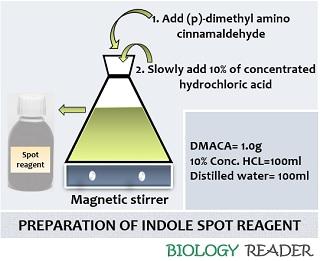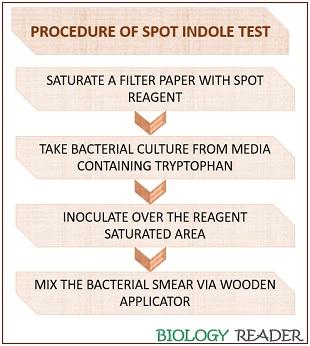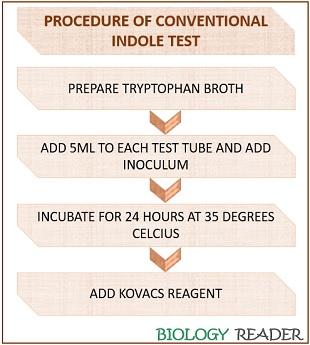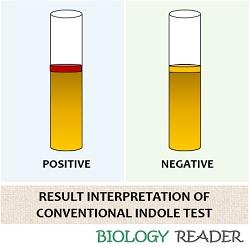Indole test is a biochemical test determining and classifying the bacteria based on their tendency to decompose amino acid (Tryptophan) into a heterocyclic organic compound (Indole). It is a part of a biochemical method popularly known as the IMViC test, in which ‘I’ stands for the indole test.
Indole is one of the end products forming after the deamination or hydrolysis of tryptophan, caused by an enzyme “Tryptophanase”. Indole test generally includes two methods, namely spot indole test and conventional indole test.
A spot tube test requires no incubation time, and it gives rapid results that are characterized by the formation of a blue-green zone. A conventional tube test involves incubation of the culture medium, and correct conclusions could be drawn only after 24 hours.
Therefore, the conventional tube method is more time taking than the spot method. In this context, we will discuss the definition, purpose, principle and procedure of the indole test. Besides, you would also get to know the test media and test reagents required to perform the indole biochemical test.
Content: Indole Test
- Definition
- Purpose
- Principle
- Indole Test Media
- Indole Test Reagents
- Methods and Procedure
- Important Facts
Definition of Indole Test
Indole test is an IMViC test procedure that aims to distinguish different members of bacteria (indole positive or indole negative organisms) based on the splitting of tryptophan present in the medium into an end product indole. It uses Kovacs reagent to classify the members of Enterobacteriaceae. Conversely, the indole test requires Ehrlich’s reagent to distinguish the non-fermentative and anaerobic bacteria.
Indole positive bacteria hold an intracellular enzyme (tryptophanase), which degrades the tryptophan amino acid into indole, whereas indole negative bacteria lack such enzyme. Indole test discriminates the different members of the Enterobacteriaceae family through one of the rapid and slow methods.
- Spot indole test is a rapid method that identifies the indole producing organisms within a few minutes.
- Conventional indole test is a slow method that requires an incubation period of 24 hours to detect the microorganisms producing indole.
Purpose
An indole test accounts for the following objectives:
- It detects the organisms based on their capacity to deaminate tryptophan into a compound known as indole.
- It classifies the different members of bacteria belonging to the Enterobacteriaceae family.
- Indole test serves as a qualitative method, which is characterized by the appearance of a coloured complex using a particular reagent.
Principle of Indole Test
In the indole test, the growth of bacteria is induced in a tryptone rich medium. Some bacteria possess an intracellular enzyme tryptophase that results in deamination of tryptophan into three end products, namely indole, pyruvic acid and ammonium.
The hydrolysis of tryptophan occurs by the removal of the amine (NH2) group and the addition of water. The addition of Kovacs and spot reagent confirms indole production in a conventional tube and spot indole method, respectively.

Spot indole method makes the use of p-Dimethylaminocinnamaldehyde reagent that couples with indole to produce a blue-coloured complex. In a conventional method, Kovacs reagent or 4(p)-dimethylaminobenzaldehyde couples with indole to develop a red-coloured compound or rosindole.
Indole Test Media
Indole test generally employs a single test medium such as “Tryptophan broth” and a combined test media like “SIM”. By using tryptophan broth, we could only distinguish among the indole positive and indole negative organisms.
In contrast to this, SIM (Sulfide Indole Motility) is a combined test medium, which differentiates the microorganisms based on their H2S production, indole production and motility.
The composition of tryptone broth requires:
- Tryptone: 10g
- Sodium chloride: 5g
- Distilled water: 1L
- pH: 7.5 0.2 (at 25 Degrees Celsius)
The composition of SIM media requires:
- Tryptone: 20g
- Peptone: 6.1g
- Agar: 3.5g
- Fe (NH)2(SO4)2.6H2O: 0.2g
- Na2S2O3.5H2O: 0.2g
- Distilled water: 1L
- pH: 7.5 0.2 (at 25 Degrees Celsius)
To inoculate the bacterial culture into the test media, we must select isolated colonies from any of the non-selective medium added with a sufficient amount of tryptophan.
Indole Test Reagent
Indole Kovacs reagent: Components of indole Kovacs reagent to prepare 100 ml of a solution include:

- 4(p)-dimethylaminobenzaldehyde: 5 g
- Amyl alcohol: 75 ml
- Concentrated hydrochloric acid: 25 ml
- Distilled water: 100 ml
Indole spot reagent: Components of indole spot reagent to prepare 100 ml of a solution include:

- (p)-Dimethylaminocinnamaldehyde: 1.0 g
- Concentrated hydrochloric acid: 10.0 ml
- Distilled water: 100 ml
Methods and Procedure
Two common methods differentiate the organisms based on indole production, namely:
- Spot indole method
- Conventional tube method
Spot Indole Method
Procedure: It includes the following steps:

- Saturate Whatman no.1 filter paper with the spot indole reagent.
- Allow it to dry for a few minutes.
- Add little bacterial inoculum via wooden applicator from any non-selective medium rich in tryptophan like Blood agar media.
- Rub the inoculum or prepare a thin bacterial smear over the reagent saturated zone.
- Observe the filter paper after 3-5 minutes for the appearance of a blue-coloured zone.
Result Interpretation
- Positive result: Blue-green colour appears over the bacterial smear.
- Negative result: A filter paper remains colourless.

Limitations
- Spot indole test is a less sensitive method.
- Inoculum should be taken from an isolated colony to prevent the diffusion of indole.
- A bacterial culture must be incubated aerobically.
- A culture should be taken from the glucose-free medium, as it may rapidly break down the indole.
- An inoculum isolated from selective media like MacConkey’s agar and Eosin methylene blue agar may give erroneous results.
- Bacteria isolated from Mueller Hinton agar can degrade tryptophan by causing acid hydrolysis of casein.
- Weak indole positive bacterium like Cardiobacterium hominis cannot be examined by this method.
Conventional Indole Method
Procedure: It includes the following steps:

- Prepare tryptone broth by accurately weighing the reagents required.
- After adding all the components in a sterilized conical flask, add an appropriate amount of sterile water and autoclave at 121 degrees Celsius on 15psi pressure for 15 minutes.
- After autoclaving, pour 5 ml of tryptone broth into each test tubes.
- Then, inoculate bacterial pure culture via the sterile inoculating loop.
- Incubate the test tubes for at least 24 hours at a temperature of 35 degrees Celsius.
- Pour 0.5 ml of Kovacs reagent and observe a red coloured complex on the top of the alcohol layer.
Result Interpretation
Positive result: A cherry red colour develops at the top.
Negative result: A medium forms a colourless or yellow compound.

Limitations
- A conventional tube method takes much time (minimum of 24 hours) to confer the results.
- It cannot differentiate among the non-fermentative and anaerobic bacteria, for which an Ehrlich reagent acts as a replacement of Kovacs reagent.
- During a reaction, a compound “Skatole” forms that may obscure the result interpretation.
- Clostridium species rapidly break indole and give false results.
Important Facts
Indole test differentiates organisms that possess tryptophanase enzyme from the organisms that lack. Tryptophanase activity causes the breakdown of tryptophan.
- Bacteria that can degrade tryptophan into indole have tryptophanase enzyme and called “Indole positive bacteria”. Examples of indole positive bacteria include Aeromonas hydrophila, Bacillus alvei, Escherichia coli, Klebsiella oxytoca etc.
- Few bacteria lack tryptophanase enzyme in their intracellular space and cannot split tryptophan into indole and called “Indole negative bacteria”. Examples of indole negative bacteria include Proteus mirabilis, Pasteurella ureae, Bacillus sp, Enterobacter sp etc.
Tryptophanase is an intracellular enzyme present in some bacteria that uses tryptophan and water as “Substrates” to produce “Products” like indole, pyruvic acid and ammonium. It belongs to the C-C lyases family, which facilitates the tryptophan metabolism via pyridoxal phosphate and potassium cofactors.
Indole (primary product) is an aromatic heterocyclic compound, which forms as a result of tryptophan hydrolysis. The indole production can be visualized by adding some coloured solution like Kovacs reagent (for tube method) and Spot reagent (for spot method).